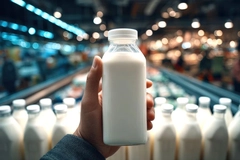US Plastics Pact report calls on businesses to tackle low recycling rates
Limited recycling access, market barriers and policy gaps are key challenges that lead to only 13.3% of plastic packaging in the US being recycled, says the US Plastics Pact. The organization's newly published 2023-24 Impact Report presents data from its member organizations, which include retailers and converters of consumer packaged goods.
The 129 businesses and organizations members of the US Plastics Pact of the pact produce 33% of the plastic packaging on the US market by weight. The top three types of plastic waste by tonnage were found to be PET bottles, high-density PE (HDPE) bottles and PP rigid packaging.
“Packaging design and consumer convenience are two key factors driving the adoption rate of sustainable packaging. Sustainability must be integrated into the design of plastic packaging to ensure it is compatible with existing recycling systems,” Jonathan Quinn, CEO of US Plastics Pact, tells Packaging Insights.
“New and existing packaging must be designed to maximize recycling value and minimize the use of problematic materials that interfere with recycling processes or contaminate recycled content. This approach enhances the efficiency and efficacy of recycling systems and increases national recycling rates, contributing to a more sustainable plastic lifecycle,” he continues.
“But packaging design must also take into account the ease of use, reuse, recyclability and compostability expected by end consumers. Consumers’ role in achieving a circular economy for plastics is as important as every other link in the plastics value chain. Without their participation, the system fails.”
Recyclability innovation
The new report states that the organization’s members are delivering solutions across the supply chain:
• Pact Collective is addressing hard-to-recycle packaging and plastic waste in the beauty industry. It introduced its NewMatter resin, a 100% recycled-content material fostering scalable closed-loop systems.
• Eastman is leveraging molecular recycling, opening the world’s largest facility of its kind in Tennessee,US, reducing emissions and diverting hard-to-recycle plastics from landfills.
• Trioworld introduced the 49ga Axis Loop film, a thinner, high-performance machine stretch film containing 30% post recycled content, cutting the amount of plastic used by up to 40% and halving carbon emissions.
• Kraft Heinz transitioned its Crystal Light packaging from plastic to recyclable paperboard, eliminating 3 million pounds of plastic annually and advancing toward a 20% reduction in virgin plastic use by 2030.
 Packaging design should take into account the ease of use, reuse, recyclability and composability.However, major problems concerning recycling in the US at present remain. According to the US Plastics Pact, these include limited access, as only 43% of households and even lower percentage of commercial and public spaces are able to do so.
Packaging design should take into account the ease of use, reuse, recyclability and composability.However, major problems concerning recycling in the US at present remain. According to the US Plastics Pact, these include limited access, as only 43% of households and even lower percentage of commercial and public spaces are able to do so.
Another one is that virgin plastic remains cheaper than recycled alternatives, stifling demand for sustainable materials. In terms of regulation, the US lacks standardized recycling definitions and cohesive national strategies.
Tackling challenges
Quinn says that one of the main challenges to increasing post-consumer recycled (PCR) content in packaging is sourcing enough PCR feedstock to make it a viable, cost-effective option when compared to virgin plastic.
“To produce enough PCR requires a major shift in consumer behavior to recycle more effectively, as well as design and manufacture plastic packaging to be easily recyclable. Supply has been a key hurdle, but we can not lose sight of the impact of quality and performance of supply, as this has implications on the levels of incorporation.”
“The US Plastics Pact has made available several resources to assist in this endeavor: the Design for Recyclability Playbook provides clear, actionable guidelines empowering companies and organizations to make informed decisions to drive substantial improvements in plastic design and management; and the PCR Toolkit assists companies to increase their use of PCR, providing resources in key areas such as Procurement, Quality Assurance and Government Affairs.”
Roadmap 2.0
The 2023-2024 Impact Report showcases the progress made in transforming how plastics are designed, used and reused. It finds that 22% of its members do not sell any items from its “Problematic and Unnecessary Materials List,” with ongoing progress through 2025.
It also states that sustainable packaging adoption in the country increased to 50%, up from 36% in 2021, with improvements in recyclability. US Plastics Pact members raised PCR content in packaging to 11%, progressing toward the 2025 goal of 30%.
 Reuse is quickly becoming a key component of a circular economy for plastics.The improvements made so far align with the organization’s 2025 targets and its newly introduced Roadmap 2.0, which extends some goals to 2030 while prioritizing scalable reuse systems, the elimination of virgin plastics and advancing recycling infrastructure.
Reuse is quickly becoming a key component of a circular economy for plastics.The improvements made so far align with the organization’s 2025 targets and its newly introduced Roadmap 2.0, which extends some goals to 2030 while prioritizing scalable reuse systems, the elimination of virgin plastics and advancing recycling infrastructure.
“The biggest change introduced in Roadmap 2.0 is a new target focused on reuse. Reuse is quickly becoming a key component of a circular economy for plastics, and by making it a core target, we have the opportunity to significantly reduce single-use plastics. All our targets are intentionally ambitious,” says Quinn.
“Modest, easily attainable goals do not spark meaningful change. The US Plastics Pact must set bold, challenging targets and act with urgency and intention if we are to achieve a circular economy for plastics in time to make a difference for our planet. The only way we can actually deliver progress is to push to achieve what some once believed to be impossible to be possible.”
Quinn tells us that the SME members of the pact “play a huge role” in its mission. “Many of these businesses are built on innovations that specifically help achieve plastics sustainability. A key element they often provide is pilot opportunities intended to be scaled broadly.”
“We are the only organization of our kind in the US with this level of plastics value chain representation, as well as this breadth of small to large organizations and companies.”












